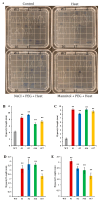A CAM-Related NF-YB Transcription Factor Enhances Multiple Abiotic Stress Tolerance in Arabidopsis
- PMID: 39000218
- PMCID: PMC11241642
- DOI: 10.3390/ijms25137107
A CAM-Related NF-YB Transcription Factor Enhances Multiple Abiotic Stress Tolerance in Arabidopsis
Abstract
Abiotic stresses often occur simultaneously, and the tolerance mechanisms of plants to combined multiple abiotic stresses remain poorly studied. Extremophytes, adapted to abiotic stressors, might possess stress-adaptive or -responsive regulators that could enhance multiple abiotic stress resistance in crop plants. We identified an NF-YB transcription factor (TF) from the heat-tolerant obligate Crassulacean acid metabolism (CAM) plant, Kalanchoe fedtschenkoi, as a potential regulator of multiple abiotic stresses. The KfNF-YB3 gene was overexpressed in Arabidopsis to determine its role in multiple abiotic stress responses. Transgenic lines exhibited accelerated flowering time, increased biomass, larger rosette size, higher seed yield, and more leaves. Transgenic lines had higher germination rates under combined NaCl, osmotic, and water-deficit stress treatments compared to control plants. They also showed enhanced root growth and survival under simultaneous NaCl, osmotic, water-deficit, and heat stress conditions in vitro. Interestingly, potted transgenic lines had higher survival rates, yield, and biomass under simultaneous heat, water-deficit, and light stresses compared to control plants. Altogether, these results provide initial insights into the functions of a CAM-related TF and its potential roles in regulating multiple abiotic stress responses. The CAM abiotic stress-responsive TF-based approach appears to be an ideal strategy to enhance multi-stress resilience in crop plants.
Keywords: Crassulacean acid metabolism; abiotic stress; climate change; extremophytes; nuclear factor Y; transcription factor.
Conflict of interest statement
The authors declare no conflicts of interest.
Figures











References
-
- Mishra V., Xiao X. Global projections of flash drought show increased risk in a warming climate. Commun. Earth Environ. 2023;4:165.
-
- Kumar A., Sangwan O., Jangra K., Kumar Chandra A. Biotic Stresses: Mechanisms and Breeding Approaches. In: Kumar Suman S., Kumar Chandra A., Kumar P., editors. Plant Stress Biology. New Delhi Publishers; New Delhi, Kolkata: 2021. p. 16.
MeSH terms
Substances
Grants and funding
LinkOut - more resources
Full Text Sources
Miscellaneous

